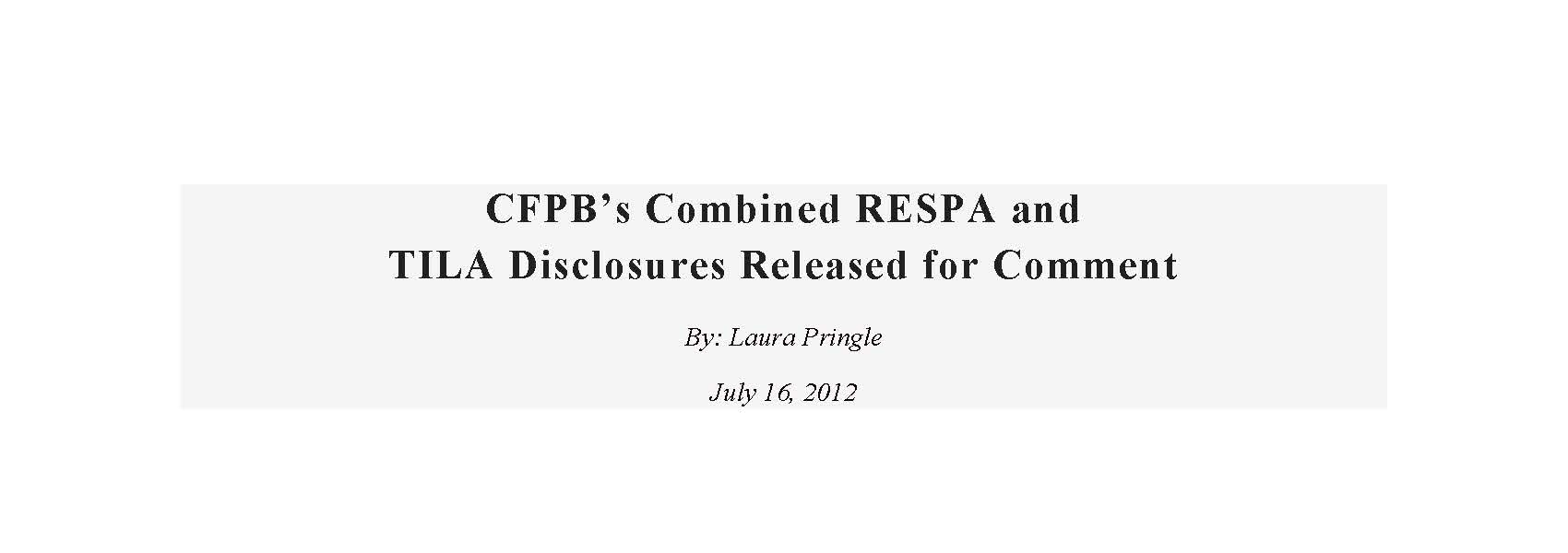CFPB's Combined RESPA and TILA Disclosures Released for Comment
By: Laura Pringle
July 16, 2012
Introduction
The CFPB’s recent release of the long-awaited proposal to combine the early disclosures and to combine the closing disclosures under the Real Estate Settlement Procedures ACT (“RESPA”) and the Truth in Lending Act (”TILA”) has created a stir of activity. As careful reviews of the proposed rules and forms are conducted and detailed comments prepared for submission to the CFPB, this article will provide quick information on the impact of these proposed changes and the time frames to begin to prepare for compliance.
Proposed Rules, Comment Periods, and Expected Compliance Date for Combined Disclosures
In order to meet several requirements in the Dodd-Frank Act by July 21, 2012, and particularly the requirements to combine disclosure forms, on July 9, 2012, the CFPB released its proposed rules to amend the RESPA’s Regulation X and the TILA’s Regulation Z (“Current Rules”) by modifying and incorporating portions of these Current Rules into the CFPB’s regulations at 12 CFR 1026. The proposals have not yet been published in the Federal Register, but the release states that the comment periods are set and will not be determined by that publication date.
Generally, the comment period on these proposed changes runs until November 6, 2012; however, for the proposed changes to the calculation of the “finance charge” and annual percentage rate (“APR”) and the delay of effective dates of several disclosures required by the Dodd-Frank Act, comments are accepted only until September 7, 2012. There is also a proposed rule which imposes additional restrictions and requirements on high-cost mortgage loans for which comments are accepted until September 7, 2012. The effective dates for compliance discussed in these proposals relating to the combined disclosure forms required by the Dodd-Frank Act generally are one year after issuance of final implementing rules; e.g., for these combined disclosures, if the final rules are not published until year-end 2012, presumably compliance would not be required until year-end 2013.
New and Revised Disclosures Forms and Scope of Coverage
The combined early TIL disclosures and RESPA good faith estimates (GFE) are found in the proposed rule in a new form H-24 titled “Loan Estimate.” The combined final TIL and RESPA disclosures are found in the proposed rule in a new form H-25 titled “Closing Disclosure.” Other new forms and revised forms provide models for a cover of the estimates and for disclosures of settlement service providers. Construction loan disclosures are readdressed including disclosures relating to handling construction loans as a balloon payment product.
The new proposed combined disclosure forms H-24 and H-25 apply to closed-end consumer credit transactions secured by real property (not mobile homes of dwelling only not attached to real property); however, the new proposed combined forms do not apply to reverse mortgages or HELOCs which are addressed in current regulations and are expected to be the subjects of revised disclosures issued separately by the CFPB. The combined disclosures do apply to construction-only loans, vacant-land loans, and loans secured by more than 25 acres, even though these transactions currently are exempt from RESPA coverage. Several other Dodd-Frank Act requirements are incorporated into these new proposed forms. Also, the proposed rules require itemization of certain settlement charges in these disclosures that are not permitted to be itemized on the current RESPA GFE settlement statement forms.
Expected Steps to Prepare for Compliance
We anticipate that during this planning period almost every financial institution will be:
(1) Planning to timely (3 days after receipt of the “application”) and accurately provide the Loan Estimate or have the mortgage broker deliver the Loan Estimate (although the lending remains responsible for the accuracy of the form); and
(2) Planning to timely (3 days prior to closing) and accurately provide closing disclosures (or, alternatively if permitted in the final rule, sharing this responsibility with the settlement agent, although the lender remains responsible for accuracy of the form).
The general steps which will be required to be taken prior to the required mandatory compliance dates once those are established in the final rule include the following:
(1) Train employees to use new forms and any new software systems;
(2) Change procedures as necessary, e.g., the definition of a loan “application” os revised to eliminate “any other information deemed necessary by the lender” triggering the timely delivery of the Loan Estimate; and
(3) Properly disclosure “finance charge” and APR under revised rules which will, as proposed, encompass almost all of the up-front costs of the loan, (similar to the Federal Reserve’s 2009 Closed-End Proposal, published August 26, 2009) which can also impact high-cost mortgage, appraisal, ability to pay, and escrow rulemakings by the CFPB.
Conclusion
The proposal in the release is over 1000 pages in length and provides extensive proposed guidance from the CFPB. That release can be found at www.consumerfinance.gov/blog/know-before-you-owe-introducing-our-proposed-mortgage-disclosure-forms/. At this time, planning to take steps during the upcoming months and in 2013 to fully prepare for compliance means simply anticipating whether and how the changes can be expected to impact your institution and what resources will be required.
©PRINGLE® 2012
This article was also published at Wolters Kluwer’s Compliance Headquarters™ website: www.complianceheadquarters.com.
